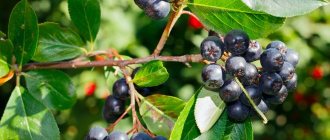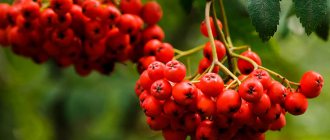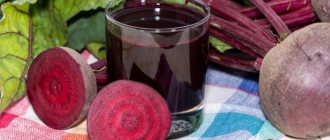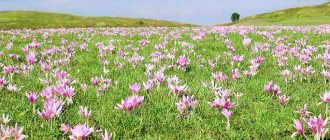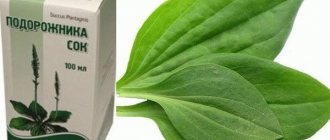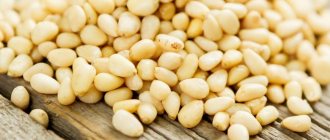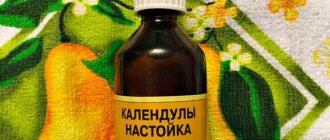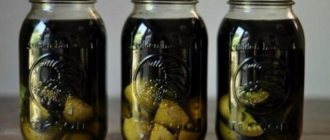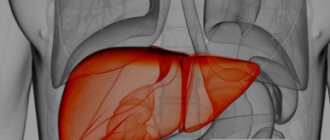Home / Cooking / Ingredients and products
Back
Published: 02/14/2019
Reading time: 11 min
1
10949
3.9 / 5 ( 8 votes)
It is known that chokeberry is beneficial for the body. Its berries are used for prevention and treatment of many diseases. What medicinal properties and contraindications does chokeberry have? How to properly prepare a decoction, tincture or mixture. How to properly prepare raw materials so that the berries have healing properties. We will consider these and other questions in an article on the website womanss.ru. In almost all garden plots you can find chokeberry (chokeberry).
It grows in the form of a small shrub or tree. Its berries are often sold in markets and private farmsteads, both dried and fresh.
They have a specific taste, bright color, and pleasant aroma. They are a strong drug. Only after agreeing with the doctor on their use in advance, do they begin treatment at home, on their own.
- Description
- Chemical composition and calorie content
- Contraindications to the use of rowan
- The healing properties of chokeberry How chokeberry helps people with hypertension (high blood pressure)
- Black rowan in the treatment of hypotension
- Healing properties of rowan for women
- Chokeberry tincture for women during menopause
- Chokeberry for men
- Treatment of the gastrointestinal tract
- Ways to use rowan for diabetes
- Chokeberry during breastfeeding
- How to properly dry chokeberry
Chemical composition and calorie content of chokeberry berries
Black rowan, caught in the frost, becomes a favorite delicacy for birds and an excellent vitamin supplement. On an intuitive level, the birds appreciated the beneficial properties of the berry, which contains a huge amount of vitamins, minerals, and trace elements.
The nutritional value of chokeberries is only 55 kcal per 100 g, they contain 1.5 protein, 0.2 fat and 10.9 g carbohydrates. Rowan contains a lot of iron and vitamin C, for which it even surpasses gooseberries, currants, and citrus fruits. Chokeberry is one of the rare natural sources of sorbitol, a sugar substitute that is allowed even for diabetes.
What else is contained in chokeberry:
- Bioflavonoids. Chokeberry contains vitamin P, which keeps blood vessels clean, smooth, and elastic. The trace element improves blood circulation, removes toxins, binds free radicals, prolonging a person’s youth and preventing neoplasms (including malignant ones).
- Microelements. Rowan is a champion in potassium content. In addition, chokeberry has a high iodine content, only slightly inferior to feijoa, a sweet and sour berry. In addition to iodine, aronia fruits contain a lot of copper, manganese, molybdenum, fluorine, boron - we are used to getting all these microelements from ready-made vitamin complexes, whereas we can get them from a natural source.
Finally, rowan contains organic acids and tannins. Pectins, tannins, sorbitol, fructose, increase the value of aronia berries. Chokeberry contains malic acid, which is recognized as a strong antioxidant and a powerful weapon in the fight against old age. Tannins make chokeberry so astringent, but they are able to stop diarrhea and improve the digestive process.
For what diseases is black rowan used?
- Atherosclerosis and hypertension. A diverse composition of vitamins and minerals improves health. Berries should be consumed with foods that are rich in vitamin C. This condition is required for vitamin P to be well absorbed in the body.
- Vascular diseases. Black rowan has an excellent effect on strengthening blood vessels and promoting their elasticity.
- Reduced stomach acidity. Chokeberry helps to activate the action of gastric juice, due to which acidity increases.
- Improving the functioning of the nervous system. To reduce emotional imbalance, juice from rowan berries is used.
- Thyroid disease. A sufficient amount of iodine, which is contained in chokeberry, helps restore the functions of the thyroid gland.
- Choleretic agent. To remove stones from the gall bladder, decoctions and rowan berries are used.
- Diabetes. Blood sugar decreases after consuming berry infusions.
- Improved appetite. Stimulates appetite and helps regulate digestion.
- Fungal infections. Fresh rowan leaves are used, which are ground and applied to the affected area.
It is important to note that black rowan does not lose its beneficial properties with any of the treatments. So it can be used in the form of jam, juice, jam, syrup, tea. It is especially useful in winter and spring, when the immune system is weakened.
The benefits of chokeberry for the body
The great advantage of the berry brought to Russia by Michurin is its surprisingly balanced ratio of all healing substances. They combine perfectly, enter into a synergistic union, that is, they enhance each other’s effects. For example, vitamins C and P promote the production of hyaluronic acid in tissues, the same one on which the elasticity, firmness and youth of the skin depend. This has made the berry in demand in cosmetology, where extracts are added to creams against wrinkles and early aging.
How does rowan affect blood pressure? Whether it increases or decreases
The ability to normalize blood pressure is one of the main qualities of chokeberry, which has been adopted by pharmaceutical companies around the world. The principle of action of the fruit is simple: chokeberry slightly thickens the blood, removes excess fluid from the body, as a result, the volume of blood circulating in the blood decreases, as does the level of its pressure on the walls of arteries and vessels.
Features of the use of chokeberry for low blood pressure
Chokeberry has different medicinal qualities, depending on how it is prepared, in what doses it is used and how often. Only regular use of rowan in courses brings a noticeable effect; if you use the berries occasionally, you cannot expect a cure.
With high blood pressure
To reduce blood pressure, drink either berry juice or compote made from dry or frozen berries. The compote is cooked quickly, do not bring to a boil. It is important to simmer the berries so that they transfer all their beneficial properties to the water. The recipe is very simple: pour 300 g of berries with 1.5 liters of water, sweeten them slightly and put the pan on the fire. As soon as the compote gets very hot and is about to boil, reduce the heat to low, cover the compote with a lid and simmer for 60 to 80 minutes. The finished drink is poured into any glass vessel and drunk half a glass 2-4 times a day before meals.
For those who do not want to bother with cooking chokeberries, we can recommend ready-made pharmaceutical preparations with chokeberry, but only after consulting a doctor.
For hypotension
Since berries, in principle, regulate blood pressure, hypotensive patients can also drink compote. Only in moderation. You can treat yourself to berry liqueur or vodka tincture: no more than 30 ml. at once. Chokeberry liqueur is made from juice, which is boiled until slightly thickened, and then vodka is added, calculating 100 g of juice per 30 ml of “fire water”. Then it is poured into a glass bottle, sealed tightly and infused in a dark, cool place for 30 to 40 days.
Medicinal recipes
Chokeberry came to the local climate from North America, where it was grown long before the arrival of the white population. Tribes of local Indians treated burns with it and made flour from it. In the 19th century, chokeberry came to Europe and gained great popularity. In Russia, the use of chokeberry began with research in 1961, after which the consumption of fruits and juice was allowed.
General strengthening decoction: dried chokeberry fruits 20 g. pour 200 ml boiling water. put on fire and simmer for 10 minutes. Cool the broth, then strain and take 0.5 cups 4 times a day before meals.
For hypertension: mix 50 grams of freshly squeezed juice with a tablespoon of honey. The course of treatment is 10-15 days, consume half an hour before meals 3 times a day. You can also consume 100 grams of fresh berries, or 50 ml of juice for 10 days, 3 times a day.
For atherosclerosis: it is recommended to consume 100 grams of berries for 2-6 weeks. Or prepare a mixture of a kilogram of berries and 700 grams of sugar. Take 100 g 2-3 times a day.
For high blood pressure: take 0.25 glasses of freshly squeezed juice 3-4 times a day before meals, half an hour. This juice is also useful for gastritis with low acidity and hemorrhoids.
Multivitamin tea: pour half a spoonful of berry puree into two glasses of boiling water, keep on fire for 10 minutes, and let steep for 5-6 hours. If desired, you can add a little sugar for taste before eating. It is recommended to drink half a glass 3-4 times a day before eating.
For anemia and vitamin deficiencies: it is recommended to consume 250 grams of fresh berries together with rosehip decoction, black currants and ascorbic acid.
Chokeberry juice: To prepare chokeberry juice, you will need the chokeberry itself, water, sugar and citric acid or lemon juice. Berries for juice must be picked already in late autumn so that the berries darken sufficiently. The berries are removed in clusters, the branches are removed before cooking. First you need to wash the berries, dry them a little and squeeze the juice out of them (about 2 kg of berries will be required), then close with a tight lid and put in the refrigerator. Pour boiling water over the cake that remains after squeezing the juice, cover with a cloth and leave to infuse for 3 hours. After three hours, strain the infusion and add to the juice.
The next step is to place the container on the fire and add sugar at the rate of 100 grams of sugar per liter of juice, as well as 0.25 teaspoon of citric acid. Let it simmer for 5 minutes, then pour it hot into a bottle that has been sterilized in advance and cover it with a lid.
Chokeberry wine: It is best to make fortified and sweet wine from rowan. Dry wines are very tart, so they are rarely prepared. Ingredients:
- Ripe rowan 5 kg;
- Sugar 1 kg;
- Raisins 50g;
- Water 1 liter.
First you need to mash all the berries with your hands or a special device. Mix mashed berries with 500 grams of sugar in a non-metallic bowl. Without added sugar, the wine will be weak and will not store well. Next, add raisins to speed up the fermentation process. Mix everything until a homogeneous mass is obtained.
Cover with gauze and put in a dark, warm place for a week. Stir several times every day. The fermentation process lasts approximately 25-30 days, as soon as the bubbles on top disappear, we can consider that fermentation is over. Ripening lasts 3-6 months under a tightly closed lid.
Chokeberry jam:
- Chokeberry 1 kg;
- Sugar 1.3 kg;
- Water 2 glasses;
- Juice 1 glass;
- Rum 1 tablespoon;
- Lemon 0.5 cups.
For jam, it is recommended to remove chokeberry fruits immediately after the onset of frost. They are washed and kept in a slightly preheated oven for two to 5 hours. Boil syrup from sugar, water and juice, add berries and rum to the syrup and keep on fire until the berries become transparent. When finished, stir in citric acid.
Chokeberry scrub recipe: we need ½ cup of berries, which must be chopped in a meat grinder or blended. Mix fine salt into the resulting mixture to make a thick mixture. Since chokeberry fruits contain small seeds, they are excellent for exfoliating and cleansing the skin.
Rowan-milk face mask: take 2 tbsp. spoons of rowan, grind in a blender. Add a teaspoon of honey and 1.5 tbsp to the resulting mask. spoons of milk. Place the resulting mixture on a gauze mask and apply to the face for 15-20 minutes.
How to treat hypertension with chokeberry
Even general practitioners have nothing against it if, along with medications, a patient with hypertension supplements treatment with chokeberry berries. Treat stage 1 and 2 hypertension with chokeberry juice, which can be easily prepared at home. The course ranges from 30 days and above, and the recommended dose is equal to a quarter glass 3 times a day. How to prepare juice? The berries are poured with water in the proportion of 1 kg of berries to 1 glass of water (250 ml), then the berries are put on fire and heated to 60 degrees. During the process, chokeberry releases juice and it is important for it to infuse a little.
Next, the chokeberry together with water is scrolled in a meat grinder and the pulp is squeezed through cheesecloth, or filtered through a sieve. The finished juice is seasoned with honey or sugar to slightly soften the astringency, and then poured into clean glass jars. You can preserve chokeberry juice, or even better, put the jar in the refrigerator and drink as needed.
Aronia juice
Chokeberry juice can be consumed fresh or prepared for the winter: it is very useful to use it regularly for blood pressure disorders, atherosclerosis, diarrhea, urolithiasis, etc.
To immediately consume the juice, chokeberry berries are carefully sorted, crushed and mixed with sugar to taste.
To prepare juice for subsequent storage, the fruits should first be washed, then dried and sorted.
Then the berries are placed in an enamel bowl, water is added there at the rate of 100 g per 1 kg of fruit, the resulting mixture is simmered over low heat for about half an hour. The temperature of the berries should be no more than 60 °C, this will preserve all the beneficial properties of rowan.
After the time has passed, the mass must be cooled, beat with a blender, strain (for example, through cheesecloth) and add sugar or honey to taste. This juice is stored in a dry, dark place and taken half an hour before meals, 0.5 cups 2-3 times a day.
If you plan to collect juice for the winter, the prepared berries should be mashed and the juice squeezed out of them (through cheesecloth or a linen bag). Water is added to the remaining pulp in a ratio of 10:1, after an hour they are squeezed out again and mixed with the previously squeezed juice (the procedure can be repeated several times, all the time reducing the amount of water).
The finished drink is poured into clean, dry jars or bottles (about 3-4 cm should remain to the top) and sterilized for 10-15 minutes (depending on the volume of the container). Then the bottles are closed with corks, and the jars with lids. The cork must be tied with a rope and, after cooling, sealed by filling it with paraffin.
When consumed, you can add sugar or honey to the juice if desired. It’s very tasty to mix it with blackcurrant juice or rosehip infusion.
Chokeberry juice, in addition to internal use, is also used as an anti-burn agent for treating affected areas of the skin.
The benefits of chokeberry for the human body
The medicinal properties of chokeberry are widely used in pharmaceuticals - extracts and extracts of chokeberry fruits are actively used as a key component of medicinal preparations. Diuretic, choleretic, hypertensive (that is, blood pressure regulating) medications are prepared with it, medications are made for the treatment of the thyroid gland, metabolic disorders, and for the restoration of the liver and gall bladder.
For women
Rowan during pregnancy is used to relieve toxicosis in the early and late stages with severe gestosis. Since the fetuses remove excess fluid, a pregnant woman swells less, and the risk of high blood pressure during pregnancy is reduced. In addition, rowan successfully fights nausea, increased salivation, and reduces sensitivity to odors.
It has been proven that those who regularly drank chokeberry juice while expecting a baby tolerated toxicosis much easier or did not notice it at all.
An advantage to reducing toxicosis is the strengthening of the placenta between mother and baby: since chokeberry improves the vascular system, the placenta becomes stronger and much better, it quickly supplies nutrients and oxygen to the small growing body.
For men
Chokeberry has one more advantage, which few people know about. Chokeberry is an excellent aphrodisiac, increasing libido. It is for this reason that healers often prescribed men a vitamin drink made from dried fruits and leaves of chokeberry to cure impotence, that is, erectile dysfunction. The decoction improves blood circulation and dilates blood vessels, which has a beneficial effect on a man’s sexual health.
To prepare the decoction, dry fruits and leaves (it is better to buy the collection at the pharmacy if you did not have time to prepare it in time), pour hot water at a temperature of 80 degrees, and infuse it in a thermos. Proportions are taken at the rate of 4 tbsp. per one liter of water. The drink is drunk 2-3 glasses a day half an hour before meals. If desired, it can be slightly sweetened with honey.
For children
From the age of two, mothers can try to introduce chokeberry into their child’s diet in the form of jelly or compotes. They save you from bloating and are used to improve peristalsis and remove heavy toxins and poisons in mild forms of poisoning. Chokeberry, on the one hand, inhibits peristalsis, relieves the feeling of heaviness and bloated belly, and on the other hand, supplies the body with healthy dietary fiber. The baby's stool improves and he begins to feel better faster. Kissel is made in the classic way: the berries are boiled in water and rubbed through a sieve. The broth is sweetened, brought to a boil, a spoonful of honey or sugar and a little starch are added to thicken it. It turns out to be a pleasant drink that kids drink with pleasure. Sometimes, if the child does not mind, jelly can be replaced with thick chokeberry puree with honey or sugar.
What else does chokeberry treat?
The sweet and sour berries of chokeberry can cope with dozens of ailments and become a preventive remedy for vitamin deficiency. The natural substance sorbitol stops the development of diabetes, and flavonoids and iron promote blood renewal, improve blood clotting and eliminate excess bad cholesterol. Chokeberry berries remove fatty plaques that clog vascular lumens and slow down the flow of plasma. The beneficial properties of chokeberry can be listed endlessly. At the same time, you can experiment each time, giving fruits to the patient in a variety of forms, and at the same time diversify his diet.
Anemia and hypovitaminosis
Chokeberry perfectly helps to recover after operations, when a person has lost a lot of blood, is weakened, and needs a quick vitamin boost. To do this, you can prepare puree or a fresh decoction of berries ground into puree. To do this, rub the chokeberry through a sieve, mix the puree with sugar, add hot water and let it cool. It is better to strain the finished drink through cheesecloth: this way the patient will drink the decoction without the risk of choking on the pulp. Recharge is carried out in a course of 7-10 days, giving the drink 20-30 minutes before meals.
Reduced immunity
Chokeberry in winter is a real salvation from colds, flu and ARVI. Since the berry contains countless useful microelements, and the main defender of the immune system, vitamin C, you can enjoy the fruits all winter, for example, in the form of jam, washed down with herbal tea.
Beneficial features
The medicinal properties of chokeberry are very valuable - the ability to normalize cholesterol levels in the blood and lower high blood pressure. For medicinal and preventive purposes, chokeberry berries are prescribed for atherosclerosis, blood clotting disorders, rheumatism, allergies, and diabetes.
In recent years, researchers have found that regular consumption of chokeberry greatly reduces the likelihood of developing atherosclerosis, improves the functioning of the liver and endocrine system - this berry is especially useful for diffuse and toxic goiter - and also strengthens the immune system.
Official medicine states that chokeberry berries are very useful as a preventive measure, as well as as an addition to basic drug treatment. The anti-inflammatory, hypotensive, antispasmodic, diuretic and choleretic, astringent and laxative properties of chokeberry are well known.
How to prepare chokeberry
The beauty of chokeberry is that most of its healing properties are perfectly preserved in dry, frozen, or canned form. Here it is important to learn how to properly prepare raw materials for future use, so that natural medicine remains always at hand.
The best ways to prepare berries
Preparation, collection. The harvest is harvested in late autumn after the first frost, when the chokeberry berries acquire sweetness and are slightly less astringent. Experienced summer residents recommend cutting off only the stalks: this will only increase the yield of chokeberries next season. You should not place baskets of berries in the sun - not only can they turn sour, but fructose, sorbitol, vitamin C and other vitamins are also destroyed in the heat.
Drying. Aronia is dried very delicately - for several hours at a temperature of 50 degrees, spread in the oven in a very thin layer. An indicator of readiness is the color of the fruit. Dried fruits change color slightly, losing their blackness. They become cherry red and rich.
A thick brown or brown tint when dried indicates that the berries have lost most of their flavonoids.
Ready chokeberry berries are poured into paper or linen bags and stored in a cool, dry place (for example, on a balcony).
Some people like to freeze chokeberry berries and preserve them, sprinkling them with sugar. Syrups are made from chokeberries, juices are distilled, jams and tinctures are made. Wine and liqueurs made from rowan are incredibly tasty and healthy. Chokeberry liqueurs come out thick, viscous, slightly viscous. This medicine is only suitable in moderate doses, and of course, it should not be given to children and adolescents.
Contraindications and possible harm
Before use, you should familiarize yourself with the list of indications and contraindications in which the plant can cause significant harm.
It is not recommended to take rowan dishes and preparations for the following conditions:
- Peptic ulcer of the stomach and duodenum.
- Erosive gastritis, as well as inflammation of the gastric mucosa with increased production of hydrochloric acid.
- Enteritis and colitis of infectious etiology.
- Hypotension, including orthostatic.
- Increased blood clotting. There is a high risk of vascular thrombosis, especially coronary thrombosis).
- Individual hypersensitivity to any components of the drug.
- Pregnancy.
- Age less than 3 years.
If any allergic reactions develop, you should immediately stop taking it and consult a doctor. The following disturbances reactivity :
- hives;
- isolated skin itching;
- angioedema.
Chokeberry contraindications
Chokeberry has both medicinal properties and contraindications. First, it is suitable for adults and children over 2 years old. Until the age of three, chokeberry can be given, but with great caution: firstly, chokeberry contains small seeds, and children can choke on them, and secondly, it can cause allergies.
In general, doctors allow the use of chokeberry fruits in their pure form, as dietary supplements, in teas, and so on. Not as an independent medicine, but as part of a complex therapy for diseases. The only exceptions are diseases such as stomach ulcers, colitis, gastritis, thrombosis - here chokeberry, like other folk remedies, can be eaten only after consultation with your doctor. It is better to use chokeberry with caution for people with kidney diseases and the entire urinary system: organic acids can provoke the formation of stones and aggravate the disease.
Berry composition
Chokeberry is low in calories, but it contains a very large amount of the following vitamins, minerals and carbohydrates:
- beta-carotene;
- vitamins of group “A”, “C”, “E”, “K”, “PP” and “B”;
- calcium;
- potassium;
- sodium;
- magnesium;
- copper;
- fluorine;
- iron;
- iodine;
- molybdenum;
- organic acids;
- fats and proteins;
- starch;
- natural sugar.
In addition, the fruits of this plant contain many pectin substances, which help remove radioactive substances and heavy metals from the body, and also prevent the proliferation of pathogenic bacteria and activate the secretion of bile.
Individual components of the medicinal shrub can normalize the functioning of the digestive system, reduce various pain sensations, and improve the condition of blood vessels and capillaries.
However, despite all the beneficial properties listed, if you have serious illnesses, you should consult your doctor about the possibility and methods of consuming chokeberry.
